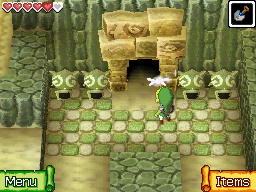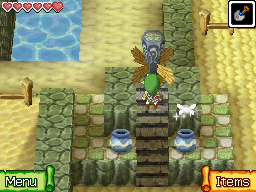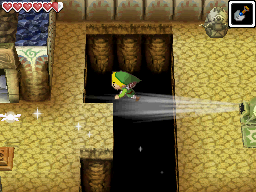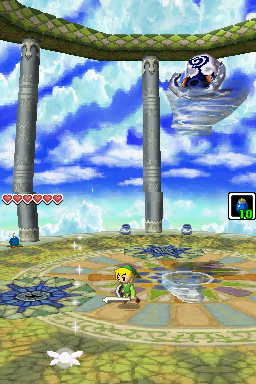Revisiting Phantom Hourglass: The Wind Temple (At Last)
Posted on March 13 2016 by Mark Olson
 After an incredible amount of, *ahem*, “build-up”, we have at long last reached the Isle of Gusts. Join me in this installment of Revisiting Phantom Hourglass as I tackle the Wind Temple in order to get the second of our three spirits. On the way, we finally get a bomb bag of our very own, have to tackle some very strong winds, and talk about introducing dungeon mechanics before the dungeon.
After an incredible amount of, *ahem*, “build-up”, we have at long last reached the Isle of Gusts. Join me in this installment of Revisiting Phantom Hourglass as I tackle the Wind Temple in order to get the second of our three spirits. On the way, we finally get a bomb bag of our very own, have to tackle some very strong winds, and talk about introducing dungeon mechanics before the dungeon.
Once the SS Linebeck makes its way through that infernal fog, we dock at the Isle of Gusts. Shortly after disembarking, a sign warns us of “strong gusts ahead”. Sure enough, every couple of seconds Link is blasted with wind and has to fight his way forward. This type of mechanic isn’t limited strictly to the outdoor portions of the island, either; even in the temple itself, players have to fight against the wind in some form or another, really setting the theme of the dungeon.
Before we can get to the dungeon, however, we have to spin three sacred windmills at the back end of the island. In doing so, we are introduced to Sandworms who, as the name might suggest, lurk underneath the sandy regions of the island. Their ears are sensitive, so, if players move too speedily, they will be gobbled up and forced to frantically rub the touchscreen to break free.

In order to get to the northern sector of the island where our target windmills are located, we have to navigate through two cave systems and a series of air jets that, when unearthed with the shovel, can shoot link up onto cliffs above. This section of the game is surprisingly lengthy for some pre-dungeon fare, and I quite enjoy it. I thought it was Skyward Sword-esque in how it allowed quite a few of the mechanics that would also be used in the dungeon proper to spill out into the over world. I think that the Isle of Gusts itself is meaty enough to justify the removal of some of the filler I complained about in the previous installment; there’s just enough here to keep players occupied for a while and introduce a few mechanics without those mechanics becoming stale.
Once we take care of those windmills we open up the Wind Temple and finally get around to exploring its depths.
Right off of the bat, Ciela lets us know that the gust mechanics introduced in the last fifteen minutes or so will continue into the dungeon. That said, it’s not exactly like the outer island; instead of blowing for five seconds followed by five seconds of rest, the wind only comes out from specialized devices. This is used in both platforming and puzzling contexts. On two occasions, the player has to carefully time when to move forward in order to avoid being blown into the abyss. On a separate, and more interesting occasion, there is a wind machine blowing across a large chasm. Players are left to figure out that they have to run in the same direction of the gust, using its added force to push you onto the target cliff.

In terms of puzzling, the usage of the wind mechanics is a little bit on the simplistic side. Towards the end of the dungeon, a short cutscene shows off two windmills on a small, upraised island, the obvious implication being that we should make them run again. To do so, we have to go the long way around (twice) and manually re-position two wind machines so that they turn the windmills. And that’s it. For being the “wind dungeon”, wind was implemented a lot less in the puzzle solving than I would like. Really, for that matter, puzzle solving as a whole was implemented a lot less than I would like. The closest I came to having to think was when a sign literally told you to blow up a section of wall unmarked by cracking, except it totally was marked thanks to a suspicious tile on the ground. On the whole, this dungeon was a bit of a combat-fest.
Speaking of combat, in this dungeon we finally get our hands on a bomb bag to call our very own. This addition to Link’s arsenal is nice, but is barely used in the dungeon besides blowing up a couple of walls (that have bomb flowers located conveniently nearby, I might add) and the boss fight. In general, very little is actually expanded upon in this dungeon. Out of all of the mechanics introduced in the past hour and a half or so, we don’t get to go deeper in anything. Bombs, wind, sand creatures… They all work in exactly the same fashion that they did prior, with no new aspects being revealed, with the exception of the one-off use of wind to propel Link to another cliff that I mentioned earlier. If you’re going to introduce mechanics before a dungeon, you should do just that; introduce them. If they are so shallow that in doing so you would give everything away, don’t even bother giving players a primer and just wait until the dungeon. I get that it’s still early on in the game, but there was no discernible increase in difficulty between the lead-up to the Wind Temple and the temple itself. Even the slightest bit of added challenge would have been more than welcome.
There was, however, a proverbial light at the end of the tunnel: the boss fight. After we find the boss key, we make our way on top of the temple. The environment looks almost like a Greek agora. The play area is surrounded by ornate pillars, the blue sky peeking out between them with visible wind gusts pushing the clouds along. The fight itself is against Cyclok, a creature reminiscent of the Great Squid from The Wind Waker that is floating within a cyclone. It summons a smaller cyclone in one of three places on the ground; players defeat the creature by waiting until it floats over one of its cyclones and then hurling a bomb into the storm. The cephalopod will then fall from the sky, permitting the player to get a few slices in with their sword. After two rounds, the creature will increase its tempo and start making bombing runs on the ground. The difference is negligible, however, and Cyclok is soon defeated.

The reason that I like this boss is really the atmosphere. I touched upon this already, but I just love the way that this fight feels. This is aided by it being the first part of the game to make use of both screens in gameplay; Link is on the bottom screen, and the flying squid is on the top. The contrast created by effectively doubling screen size gives a wonderful sense of scale to the battle and just adds a little bit of extra wallop to the boss fight, creating a really great exclamation point on a rather boring dungeon.
I’m going to be honest, this temple is a little bit on the boring side. It’s not appalling by any means, but it also doesn’t do anything else that’s particularly exciting. The one major aspect of the dungeon that I haven’t yet touched on is its visual style, and this was intentional. The look of the Wind Temple is an exemplary microcosm of the dungeon as a whole; its earthy tans and browns are serviceable, but also incredibly drab and forgettable. For the previous installments of this series, I would play through a section of the game, and then outline the article from memory, reserving the use of the internet for fact checking when I was done. For this installment, however, I immediately hopped onto our walkthrough here at Zelda Dungeon and wrote the piece with the walkthrough by my side. I barely remembered anything about the sequence of what happened or which puzzle went where, and that’s not a good sign. That said, the dungeon didn’t do anything horrifically wrong, and the boss fight was a lot of fun.
Next week, we’ll take advantage of the powers of Neri, our new-found spirit friend, and make a third trip to the Temple of the Ocean King in the hopes that it will illuminate our path the the final spirit. Thanks for reading and, as always, feel free to leave your own thoughts below.



